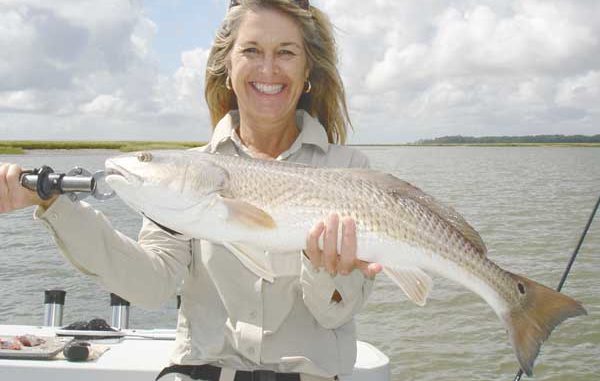
The Hilton Head area has plenty of great habitat for summertime reds.
Summer is the right time to head to the beach, and plenty of South Carolinians will be headed to Hilton Head Island. This world-famous resort town, probably best known for its quality golf courses, is surrounded by some extremely productive saltwater fishing spots. Tarpon, cobia and tripletail are common, but for a rod-bending inshore fight along the spartina grass, make sure you target redfish while on vacation.
Traveling south on I-95, you pass Ridgeland, a sleepy hamlet in fast-growing Jasper County. Before you reach the Savannah River and the Georgia state line, you take a turn for the coast onto Highway 278. The wooden signage and golf courses along the roadside are the unmistakable hallmarks of Hilton Head Island.
But when you cross the bridges over Mackay’s Creek and Skull Creek, you see a vast expanse of tidal creeks, oyster beds and marshlands that look so inviting to a fisherman.
Capt. Mike Upchurch is a product of the Lowcountry who grew up fishing in nearby St. Helena Sound, a part of the ACE Basin. He has been guiding exclusively in the Hilton Head area for the past eight years after falling in love with the estuary system.
The ACE Basin is drained by three rivers: the Ashepoo, Combahee and Edisto. Hilton Head’s Port Royal Sound is influenced by the Broad River, where there is less of an issue with freshwater intake.
Upchurch said, “The combined riverine network tends to dump muddy freshwater into St. Helena Sound long after any rains may have passed.”
Upchurch operates Osprey Charters out of Skull Creek Marina. He likes to target “pig” redfish — especially when sight-fishing is involved. The Intracoastal Waterway runs through Skull Creek, and there are plenty of docks, shellbanks and tidal rips for anglers to investigate.
Leaving Skull Creek Marina in Upchurch’s 24-foot Triton center console and heading toward Port Royal Sound, there is a thin strip of marsh that fronts some of Hilton Head Plantation’s fine homes. Some homes have docks, but most do not, making for a nice patchwork of structure and marsh to cruise in search of redfish.
“When you’re sight-fishing for redfish, your first cast is the most crucial, as you will likely have worked hard to get the correct position on the fish,” Upchurch said. “You are trying to work the angle of the sunlight against any hardbottom reflection you may see, so that you can see the fish from as far away as possible.”
Fishing a falling tide — two hours after high — redfish begin to leave the high bank of marsh grass to stage on another bank. This makes them available to anglers casting artificial baits such as Gulp! peeler crabs and shrimp. A 2-inch crab in brown or a 4-inch shrimp in Glow or Root beer colors are local favorites.
As the tide continues to ebb and approaches dead low, redfish will abandon the marsh and seek deeper waters. When they get there and disappear from view, that’s the time to switch to a cut-bait or live-bait style of fishing, using cut mullet, shrimp or mud minnows.
Large numbers of redfish can be found around the 4,000-acre Pinckney Island National Wildlife Refuge, 67 percent of which is composed of salt marsh and tidal creeks. Study the marsh, oyster bars and sand points at low tide; when they become submerged, those structures will represent the most-likely locations for fish to gather. Sight-fish when you see nervous water, or soak some bait in a likely spot — and see if you can outwit a redfish.
Fly-fishing around the shell banks is a risk-and-reward proposition because of the chance of getting hooked up and then cut off. Upchurch, who uses a 9-weight Sage fly rod, said that the legendary Lefty Kreh taught him a valuable lesson, saying, “You can throw any fly you want for redfish — just as long as it’s a chartreuse Clouser minnow!”
Upchurch, who uses 9-weight floating fly line, also likes to cast crab flies and shrimp flies along the edge of the grass.
Fishing in the waters of Hazard Creek, Broad Creek, Skull Creek, the Chechessee River and the Broad River puts you right into the thick of things with redfish. Upchurch’s No. 1 rule is to avoid fishing during an east wind, which blows across Port Royal Sound and creates too much disturbance.
Travers Davis at Lowcountry Outfitters in Bluffton, one of the area’s top tackle shops, said he likes to start his redfish trips with a white DOA shrimp rigged weedless under a Cajun Thunder popping cork — which helps attract redfish with sound. His second option is a Saltwater Assassin in electric chicken (color) fished on jigheads. Some folks also like the 3-inch Gulp! Pogies and Swimming Shads.
Capt. Brian Vaughn was born and raised on Hilton Head and has 20 years of experience guiding fishermen in area waters. He loves to get on the poling platform of his 18-foot Hewes flats boat and plow into the shallows of the marsh during a flood tide, particularly around the islands known as “Hummocks.” He likes a 7-foot medium-action rod and a Shimano reel spooled with 30-pound Power Pro braided line in Phantom Red color, which he says is almost invisible in the water.
When casting a soft-plastic jerkbait rigged weedless, he also likes the electric chicken color. When using bait, he uses a 3/0 black Eagle Claw circle hook because redfish are normally hooked in the corner of the mouth and can easily be released alive. If casting flies, Vaughn prefers a weedless crab pattern or tiny spoon flies.
“The reds average 23 inches or more, and there are plenty of 5-pounders to be found,” said Vaughn.
Ninety percent of the redfish caught on his boat are released, and he stresses proper handling of the redfish by his clients. He uses a Boga grip but said, “Hold the fish horizontally with one hand under the body for support when taking photos.”
South Carolina regulations call for a “slot limit” on redfish. Any fish shorter than 15 inches or longer than 23 inches must be returned to the water. Anything within that slot is available to keep, but there is a 3-fish daily creel limit. Regulations can be found on the DNR’s website, www.dnr.sc.gov.

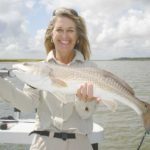
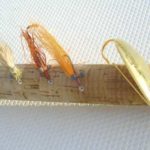
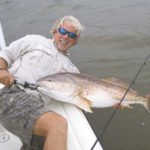
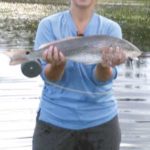
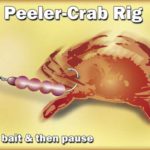
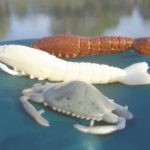
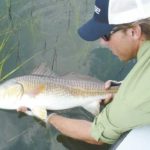



Be the first to comment